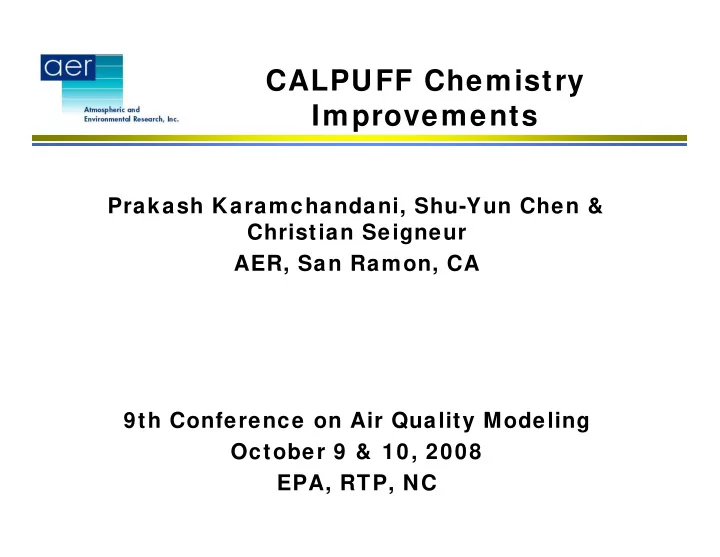

CALPUFF Chemistry Improvements Prakash Karamchandani, Shu-Yun Chen & Christian Seigneur AER, San Ramon, CA 9th Conference on Air Quality Modeling October 9 & 10, 2008 EPA, RTP, NC
Reactive Plume Models • Tw o major reactive plume models currently available for impact assessments: – CALPUFF (recommended by EPA for PSD and BART analyses) – SCIPUFF/SCICHEM (alternative model)
CALPUFF vs. SCICHEM • SCICHEM • CALPUFF – 2nd order closure – 1st order closure diffusion diffusion – Comprehensive – Simple chemistry chemistry – Computationally – Computationally efficient demanding – Regulatory model – Alternative w ith prescribed model options for typical applications
CALPUFF Chemistry Upgrade- Issues • Gas-phase chemistry highly simplified but difficult to replace w ith comprehensive chemistry: – Significant development effort to implement non-linear chemistry – Increases complexity of model – Alternative puff models w ith detailed chemistry already available (e.g., SCICHEM)
CALPUFF Chemistry Upgrade- Approach • Correct an existing error in the RIVAD gas- phase chemistry option and update RIVAD chemistry rate constants • Focus on improving treatments for PM formation and cloud chemistry • All new modules added as new options – none of the previous CALPUFF chemistry options modified
Chemistry of NO x Plumes 3 2 Long-range Plume Early Plume Mid-range Plume Dispersion Dispersion Dispersion 1 Reduced VOC/NO x /O 3 NO/NO 2 /O 3 Full VOC/NO x /O 3 chemistry — chemistry chemistry — acid formation from acid and O 3 formation OH and NO 3 /N 2 O 5 chemistry
RIVAD Chemistry Option in CALPUFF • The RIVAD chemistry option in CALPUFF uses Stage 1 chemistry for NO/NO 2 /O 3 and part of Stage 2 chemistry for OH and the formation of H 2 SO 4 and HNO 3 • O 3 puff concentration in CALPUFF is replenished to its background value at each time step; the code must be corrected to account for the O 3 depletion in the puff in the early stages of plume dispersion • Correction: Store puff O 3 history and calculate new puff O 3 concentration at each time step
Ozone Depletion in a Fresh Plume Helicopter measurements of Cumberland power plant plume, July 6, 1999; downwind distance = 11 km
Original PM Chemistry in CALPUFF • PM chemistry includes formation of inorganic species (sulfate, nitrate and ammonium) and organic species (secondary organic aerosols, SOA) • H 2 SO 4 and HNO 3 lead to the formation of ammonium sulfate and ammonium nitrate according to a simple gas/particle algorithm that uses a constant NH 3 concentration • Includes a treatment for the formation of SOA from anthropogenic and biogenic VOCs (developed for Wyoming DEQ) – simplified treatment – only includes toluene and xylene as anthropogenic SOA precursors
New PM Chemistry in CALPUFF • Formation of ammonium sulfate and ammonium nitrate is treated w ith the thermodynamic equilibrium model ISORROPIA • Inorganic PM formation that is now consistent w ith that of other operational models (e.g., CMAQ) w hile retaining computational efficiency • Formation of SOA includes oxidation of anthropogenic VOCs (aromatics, long-chain alkanes and PAH) by OH to form condensable products, w hich are partitioned according to Pankow ’s absorption algorithm (based on MADRID formulation)
Original CALPUFF Cloud Chemistry • No explicit treatment of aqueous-phase chemistry • MESOPUFF-II chemistry option uses a simple parameterization to approximate the increased oxidation of SO 2 in presence of clouds or fog: – function of relative humidity (RH) – may significantly underestimate SO 2 oxidation rates w hen clouds are present – may overestimate SO 2 oxidation w hen clouds are not present but RH is high
New Cloud Chemistry in CALPUFF • Based on CMAQ treatment • Includes SO 2 oxidation by hydrogen peroxide and ozone as w ell as iron and manganese catalyzed oxidation by oxygen • Includes gas-aqueous equilibria to calculate liquid-phase concentrations and cloud pH
CALPUFF Upgrade & Testing • Gas-phase chemistry corrections and new PM and aqueous-phase chemistry modules incorporated into 2 versions of CALPUFF – Unofficial Version 6 (April 2006 release ) – EPA-approved Version 5.8 (June 2007 release ) • Box-model sensitivity studies w ith old and new inorganic PM modules • Original (MCHEM options = 3,4) and new (MCHEM options = 5,6) CALPUFF codes tested using a pow er plant plume database used in previous SCICHEM/CALPUFF studies
Box-Model Sensitivity Studies w ith Inorganic PM Modules • Sensitivity of original CALPUFF module (MESOPUFF) and new CALPUFF module (ISORROPIA) to – Relative humidity – Temperature – Background ammonia – Background sulfate – Total nitrate
Sensitivity to Relative Humidity
Sensitivity to Temperature
Effect of O 3 Correction CALPUFF Results
CALPUFF Results - Inorganic PM Module Comparison
CALPUFF Results - Inorganic PM Module Comparison at High RH (95%)
CALPUFF Results - Organic PM (SOA) Module Comparison
CALPUFF Results Aqueous-Phase Chemistry Cloud cover and liquid w ater content hard- coded for testing aqueous-phase chemistry option
Shortcoming in CALPUFF Ammonia Treatment Temperature = 0 o C Theoretical maximum PM nitrate Ammonia limitation handled in POSTUTIL (optional CALPUFF post-processing program)
Ongoing Work • Model is currently being evaluated w ith the Southw est Wyoming Technical Air Forum (SWWYTAF) data base • Additional model updates: – Update ammonia limitation method in POSTUTIL to use ISORROPIA algorithm – Allow vertical profiles in input ammonia concentrations
Recommendations • Modify CALPUFF to read 3-D grid model outputs – More realistic specification of oxidant (OH, O 3 , H 2 O 2 ) and ammonia concentrations – Temporal and spatial variability • Include cloud fields in CALMET and CALPUFF for using the aqueous-phase chemistry option • Additional testing and evaluation of new chemistry options w ith other data bases
Acknow ledgments • API: – Provided funding for this study and ongoing CALMET/CALPUFF evaluation study w ith SWWYTAF data base • Wyoming Department of Environmental Quality: – Provided SWWYTAF data base for model application and evaluation for ongoing evaluation study
Recommend
More recommend